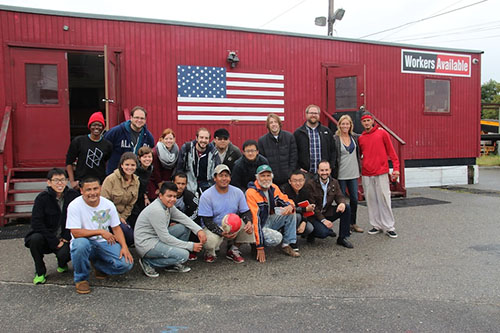In the wake of World War II, New York’s Long Island was the epicenter of the United States’s suburban craze. Mass-produced housing tracts leapt into existence on former agricultural plots and undeveloped land. Television sitcoms engrained the region’s broad front lawns, tidy homes, and cul-de-sacs into the American consciousness. For decades, homogenous, sprawling communities grew in both population and wealth.
Long Island in the 21st century bears, however, less and less resemblance to this iconic suburbia. In recent years, the region’s towns have been roiled by a number of significant changes, including the threat of sea level rise, an influx of minority residents, and an aging population. These trends were explored in-depth by a Harvard University Graduate School of Design option studio entitled the Storm, the Strife, and Everyday Life: Sea Change in the Suburbs. Led by design critic Daniel D’Oca (MUP ’02), this studio tasked each student with examining a major concern in the suburbs.
At the studio’s final review, Robert Wellburn (MUP ’15) described how he examined the role of public space in the suburbs. Wellburn used Google Street View to observe how Long Island residents use their front yards, sidewalks, and streets. This review suggested that many people occupy streets and corners, rather than formal public spaces, for recreation. Said Wellburn, “When there isn’t a provision of public space, people make their own.”
People have created vibrant public spaces in the suburbs through small-scale interventions, such as roadside retail or appropriation of the street for sports. Wellburn proposed that city government fund “light touch interventions” that support this activity, such as public seating outside of parks. These interventions could be prioritized through a public grant-making process, with applicants receiving up to $5,000 derived from illegal dumping fees.
David Henning (MUP ’15) also examined the question of how to enliven suburban space. Henning studied Prospect Avenue in New Castle, Long Island. The site intrigued Henning because neighborhood stakeholders have already implemented a number of interventions aimed at stimulating activity, but the street remains underutilized. The foundation of Henning’s project was an examination of “how different constituencies can form to create change.” For instance, Henning explored how community groups might come together to create additional bicycle infrastructure, generate programming for seniors in strategic spaces, or transform vacant storefronts into studios for light manufacturing.
Both Henning’s and Wellburn’s projects were guided by desires to capitalize on existing resources and be eminently feasible, Said Henning, “[The goal was to] find something that’s already going on and make it easier and build on it.” Wellburn agreed, adding that the process of designing an intervention is also very important. Said Wellburn, “[We were interested in] creating a process whereby people feel empowered by the change occurring in suburbia.”
